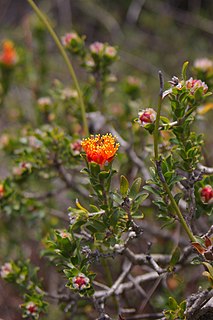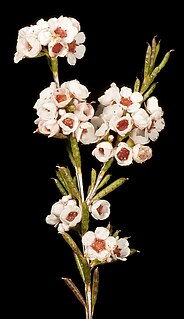
Myrtaceae or the myrtle family is a family of dicotyledonous plants placed within the order Myrtales. Myrtle, pohutukawa, bay rum tree, clove, guava, acca (feijoa), allspice, and eucalyptus are some notable members of this group. All species are woody, contain essential oils, and have flower parts in multiples of four or five. The leaves are evergreen, alternate to mostly opposite, simple, and usually entire. The flowers have a base number of five petals, though in several genera the petals are minute or absent. The stamens are usually very conspicuous, brightly coloured and numerous.

Metrosideros is a genus of approximately 60 trees, shrubs, and vines mostly found in the Pacific region in the family Myrtaceae. Most of the tree forms are small, but some are exceptionally large, the New Zealand species in particular. The name derives from the Ancient Greek metra or "heartwood" and sideron or "iron". Perhaps the best-known species are the pōhutukawa, northern rātā, and southern rātā of New Zealand, and ʻōhiʻa lehua,, from the Hawaiian Islands.

Agonis is a genus in the plant family Myrtaceae. All are endemic to Western Australia, growing near the coast in the south west.

Alexander Segger George is a Western Australian botanist. He is the authority on the plant genera Banksia and Dryandra. The "bizarre" Restionaceae genus Alexgeorgea was named in his honour in 1976.

Chamelaucium, also known as waxflower, is a genus of shrubs endemic to south western Western Australia. They belong to the myrtle family Myrtaceae and have flowers similar to those of the tea-trees (Leptospermum). The most well-known species is the Geraldton Wax, Chamelaucium uncinatum, which is cultivated widely for its large attractive flowers.

Eremaea is a genus of woody shrubs and small trees in the family Myrtaceae and is endemic to the south-west of Western Australia. Little study of the genus as a whole had been undertaken until Roger Hnatiuk researched Eremaea and published a paper in 1993, A revision of the genus Eremaea (Myrtaceae) in Nuytsia. The first species to be described was Eremaea pauciflora in 1837 and by 1964, the number of species known had increased to 12. Hnatiuk recognised 16 species, 5 subspecies and a number of varieties.

Scholtzia is a genus of flowering plants in the family Myrtaceae, which are endemic to the south-west of Western Australia. The genus was first described by Schauer in 1843, who named it in honour of the physician Heinrich Scholtz. The type species is Scholtzia obovata.

The flora of Australia comprises a vast assemblage of plant species estimated to over 20,000 vascular and 14,000 non-vascular plants, 250,000 species of fungi and over 3,000 lichens. The flora has strong affinities with the flora of Gondwana, and below the family level has a highly endemic angiosperm flora whose diversity was shaped by the effects of continental drift and climate change since the Cretaceous. Prominent features of the Australian flora are adaptations to aridity and fire which include scleromorphy and serotiny. These adaptations are common in species from the large and well-known families Proteaceae (Banksia), Myrtaceae, and Fabaceae.

Aluta is a genus of small shrubs in the family Myrtaceae. Species occur in Western Australia, South Australia and the Northern Territory. When the genus was erected in 2000, three species were transferred from the genus Thryptomene.

Cyathostemon is a genus of flowering plants in the myrtle family, Myrtaceae. The genus is endemic to southwestern Western Australia. The genus was first described by Nikolai Turczaninow in 1852. Species include:

Malleostemon is a genus of flowering plants in the myrtle family Myrtaceae, described as a genus in 1983, by John Green The entire genus is endemic to Western Australia.
- Malleostemon costatusRye & Trudgen
- Malleostemon decipiens(W.Fitzg.) Trudgen
- Malleostemon hursthousei(W.Fitzg.) J.W.Green
- Malleostemon microphyllusRye & Trudgen
- Malleostemon minilyaensisJ.W.Green
- Malleostemon nephroideusRye
- Malleostemon nerrenensisRye & Trudgen
- Malleostemon pedunculatusJ.W.Green
- Malleostemon peltiger(S.Moore) J.W.Green
- Malleostemon pustulatusRye
- Malleostemon roseus(E.Pritz.) J.W.Green
- Malleostemon tuberculatus(E.Pritz.) J.W.Green
- Malleostemon uniflorusRye

Cyathostemon ambiguus is a member of the family Myrtaceae endemic to Western Australia.
Cyathostemon divaricatus is a member of the family Myrtaceae endemic to Western Australia.
Cyathostemon gracilis is a member of the family Myrtaceae endemic to Western Australia.

Cyathostemon heterantherus is a member of the family Myrtaceae endemic to Western Australia.
Cyathostemon tenuifolius is a member of the family Myrtaceae endemic to Western Australia.
Cyathostemon verrucosus is a member of the family Myrtaceae endemic to Western Australia.
Hypocalymma minus is a member of the family Myrtaceae endemic to Western Australia.
Barbara Lynette Rye is an Australian botanist born in 1952.
Malcolm Eric Trudgen is a West Australian botanist. He has published some 105 botanical names. He currently runs his own consulting company, ME Trudgen and Associates.












